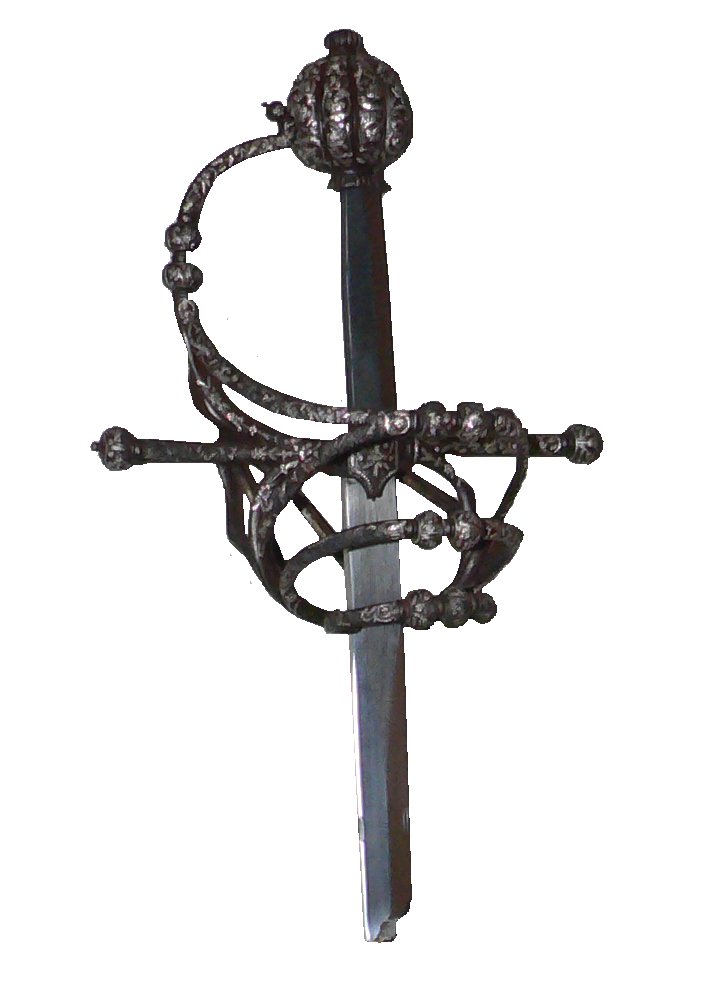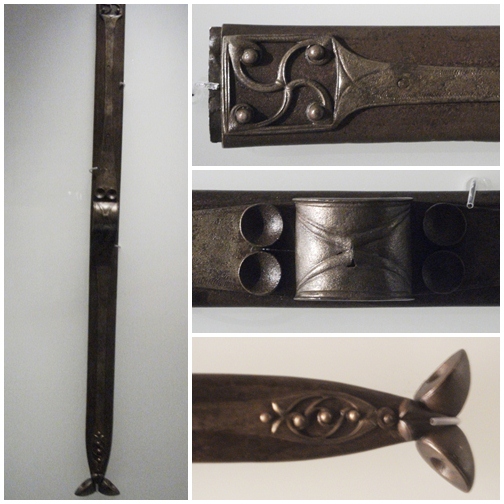|
Moplah (sword)
The Moplah sword is a sword used by the Muslim population in the Malabar Coast in southwestern India. The Moplah sword has been used since the 17th Century, both as a weapon and a tool. The Moplah sword has a light, wide and double-edged blade which is broader near to the tip, and runs slightly concave. The blade is polished smooth, with no hollow-ground. In some versions, the blade has a strong middle section, which extends up into the tip. The hilt is made of carved wood, horn or bone. The pommel is often covered with a metal disk. At the transition between the blade and hilt, decorations are often found, of traditional or religious significance in most cases. The blades are about 35 cm long, at the widest point about 10 cm wide and the sword has a total length of about 60 cm. The sword was without a scabbard A scabbard is a sheath for holding a sword, knife, or other large blade. As well, rifles may be stored in a scabbard by horse riders. Military cavalry and c ... [...More Info...] [...Related Items...] OR: [Wikipedia] [Google] [Baidu] |
Moplah
Mappila Muslim, often shortened to Mappila, formerly anglicized as Moplah/Mopla and historically known as Jonaka/Chonaka Mappila or Moors Mopulars/Mouros da Terra and Mouros Malabares, in general, is a member of the Muslim community of same name found predominantly in Kerala and Lakshadweep Islands, in southern India. Muslims of Kerala make up 26.56% of the population of the state (2011), and as a religious group they are the second largest group after Hindus (54.73%). Mappilas share the common language of Malayalam with the other religious communities of Kerala.Miller, Roland. E., "Mappila" in "The Encyclopedia of Islam". Volume VI. E. J. Brill, Leiden. 198 pp. 458–56. According to some scholars, the Mappilas are the oldest settled native Muslim community in South Asia. In general, a Mappila is either a descendant of any native convert to Islam or a mixed descendant of any Middle Eastern — Arab or Persian — individual.Hafiz Mohamad, N. P. "Socioeconomic determinants o ... [...More Info...] [...Related Items...] OR: [Wikipedia] [Google] [Baidu] |
Malabar Coast
The Malabar Coast is the southwestern coast of the Indian subcontinent. Geographically, it comprises the wettest regions of southern India, as the Western Ghats intercept the moisture-laden monsoon rains, especially on their westward-facing mountain slopes. The term is used to refer to the entire Indian coast from the western coast of Konkan to the tip of India at Kanyakumari. The peak of Anamudi, which is also the point of highest altitude in India outside the Himalayas, and Kuttanad, which is the point of least elevation in India, lie on the Malabar Coast. Kuttanad, also known as ''The Rice Bowl of Kerala'', has the lowest altitude in India, and is also one of the few places in the world where cultivation takes place below sea level. The region parallel to the Malabar Coast gently slopes from the eastern highland of Western Ghats ranges to the western coastal lowland. The moisture-laden winds of the Southwest monsoon, on reaching the southernmost point of the Indian Pe ... [...More Info...] [...Related Items...] OR: [Wikipedia] [Google] [Baidu] |
Sword
A sword is an edged, bladed weapon intended for manual cutting or thrusting. Its blade, longer than a knife or dagger, is attached to a hilt and can be straight or curved. A thrusting sword tends to have a straighter blade with a pointed tip. A slashing sword is more likely to be curved and to have a sharpened cutting edge on one or both sides of the blade. Many swords are designed for both thrusting and slashing. The precise definition of a sword varies by historical epoch and geographic region. Historically, the sword developed in the Bronze Age, evolving from the dagger; the earliest specimens date to about 1600 BC. The later Iron Age sword remained fairly short and without a crossguard. The spatha, as it developed in the Late Roman army, became the predecessor of the European sword of the Middle Ages, at first adopted as the Migration Period sword, and only in the High Middle Ages, developed into the classical arming sword with crossguard. The word '' sword'' con ... [...More Info...] [...Related Items...] OR: [Wikipedia] [Google] [Baidu] |
Concave
Concave or concavity may refer to: Science and technology * Concave lens * Concave mirror Mathematics * Concave function, the negative of a convex function * Concave polygon, a polygon which is not convex * Concave set In geometry, a subset of a Euclidean space, or more generally an affine space over the reals, is convex if, given any two points in the subset, the subset contains the whole line segment that joins them. Equivalently, a convex set or a conve ... * The concavity of a function, determined by its second derivative See also * {{disambiguation, math ... [...More Info...] [...Related Items...] OR: [Wikipedia] [Google] [Baidu] |
Hilt
The hilt (rarely called a haft or shaft) of a knife, dagger, sword, or bayonet is its handle, consisting of a guard, grip and pommel. The guard may contain a crossguard or quillons. A tassel or sword knot may be attached to the guard or pommel. Pommel The pommel ( Anglo-Norman "little apple") is an enlarged fitting at the top of the handle. They were originally developed to prevent the sword from slipping from the hand. From around the 11th century in Europe they became heavy enough to be a counterweight to the blade. This gave the sword a point of balance not too far from the hilt allowing a more fluid fighting style. Depending on sword design and swordsmanship style, the pommel may also be used to strike the opponent (e.g., using the Mordhau technique). Pommels have appeared in a wide variety of shapes, including oblate spheroids, crescents, disks, wheels, and animal or bird heads. They are often engraved or inlayed with various designs and occasionally gilt and ... [...More Info...] [...Related Items...] OR: [Wikipedia] [Google] [Baidu] |
Scabbard
A scabbard is a sheath for holding a sword, knife, or other large blade. As well, rifles may be stored in a scabbard by horse riders. Military cavalry and cowboys had scabbards for their saddle ring carbine rifles and lever-action rifles on their horses for storage and protection. Scabbards have been made of many materials over the millennia, including leather, wood, and metals such as brass or steel. Most commonly, sword scabbards were worn suspended from a sword belt or shoulder belt called a baldric. Antiquity Wooden scabbards were typically covered in fabric or leather; the leather versions also usually bore metal fittings for added protection and carrying ease. Japanese blades typically have their sharp cutting edge protected by a wooden scabbard called a saya. Many scabbards, such as ones the Greeks and Romans used, were small and light. It was designed for holding the sword rather than protecting it. All-metal scabbards were popular items for a display of wealt ... [...More Info...] [...Related Items...] OR: [Wikipedia] [Google] [Baidu] |
In All Countries And In All Times
IN, In or in may refer to: Places * India (country code IN) * Indiana, United States (postal code IN) * Ingolstadt, Germany (license plate code IN) * In, Russia, a town in the Jewish Autonomous Oblast Businesses and organizations * Independent Network, a UK-based political association * Indiana Northeastern Railroad (Association of American Railroads reporting mark) * Indian Navy, a part of the India military * Infantry, the branch of a military force that fights on foot * IN Groupe , the producer of French official documents * MAT Macedonian Airlines (IATA designator IN) * Nam Air (IATA designator IN) Science and technology * .in, the internet top-level domain of India * Inch (in), a unit of length * Indium, symbol In, a chemical element * Intelligent Network, a telecommunication network standard * Intra-nasal (insufflation), a method of administrating some medications and vaccines * Integrase, a retroviral enzyme Other uses * ''In'' (album), by the Outsiders, 1967 * In ... [...More Info...] [...Related Items...] OR: [Wikipedia] [Google] [Baidu] |
Blade Weapons
An edged weapon, or bladed weapon, is a melee weapon with a cutting edge. Bladed weapons include swords, daggers, knives, and bayonets. Edged weapons are used to cut, hack, or slash; some edged weapons (such as many kinds of swords) may also permit thrusting and stabbing. Edged weapons contrast with blunt weapons such as maces, and with thrusting weapons such as spears. Many edged agricultural tools such as machetes, hatchets, pitchforks, axes, sickles, sling blades, and scythes, have been used as improvised weapons by peasantry, militia, or irregular forces – particularly as an expedient for defence. Edged weapons and blades are associated with the premodern age but continue to be used in modern armies. Combat knives and knife bayonets are used for close combat or stealth operations and are issued as a secondary or sidearm. Modern bayonets are often intended to be used in a dual role as both a combat knife and knife bayonet. Improvised edged weapons were extensively us ... [...More Info...] [...Related Items...] OR: [Wikipedia] [Google] [Baidu] |
Indian Swords
Indian or Indians may refer to: Peoples South Asia * Indian people, people of Indian nationality, or people who have an Indian ancestor ** Non-resident Indian, a citizen of India who has temporarily emigrated to another country * South Asian ethnic groups, referring to people of the Indian subcontinent, as well as the greater South Asia region prior to the 1947 partition of India * Anglo-Indians, people with mixed Indian and British ancestry, or people of British descent born or living in the Indian subcontinent * East Indians, a Christian community in India Europe * British Indians, British people of Indian origin The Americas * Indo-Canadians, Canadian people of Indian origin * Indian Americans, American people of Indian origin * Indigenous peoples of the Americas, the pre-Columbian inhabitants of the Americas and their descendants ** Plains Indians, the common name for the Native Americans who lived on the Great Plains of North America ** Native Americans in the U ... [...More Info...] [...Related Items...] OR: [Wikipedia] [Google] [Baidu] |
Mappilas
Mappila Muslim, often shortened to Mappila, formerly anglicized as Moplah/Mopla and historically known as Jonaka/Chonaka Mappila or Moors Mopulars/Mouros da Terra and Mouros Malabares, in general, is a member of the Muslim community of same name found predominantly in Kerala and Lakshadweep Islands, in southern India. Muslims of Kerala make up 26.56% of the population of the state (2011), and as a religious group they are the second largest group after Hindus (54.73%). Mappilas share the common language of Malayalam with the other religious communities of Kerala.Miller, Roland. E., "Mappila" in "The Encyclopedia of Islam". Volume VI. E. J. Brill, Leiden. 198 pp. 458–56. According to some scholars, the Mappilas are the oldest settled native Muslim community in South Asia. In general, a Mappila is either a descendant of any native convert to Islam or a mixed descendant of any Middle Eastern — Arab or Persian — individual.Hafiz Mohamad, N. P. "Socioeconomic determinants o ... [...More Info...] [...Related Items...] OR: [Wikipedia] [Google] [Baidu] |





